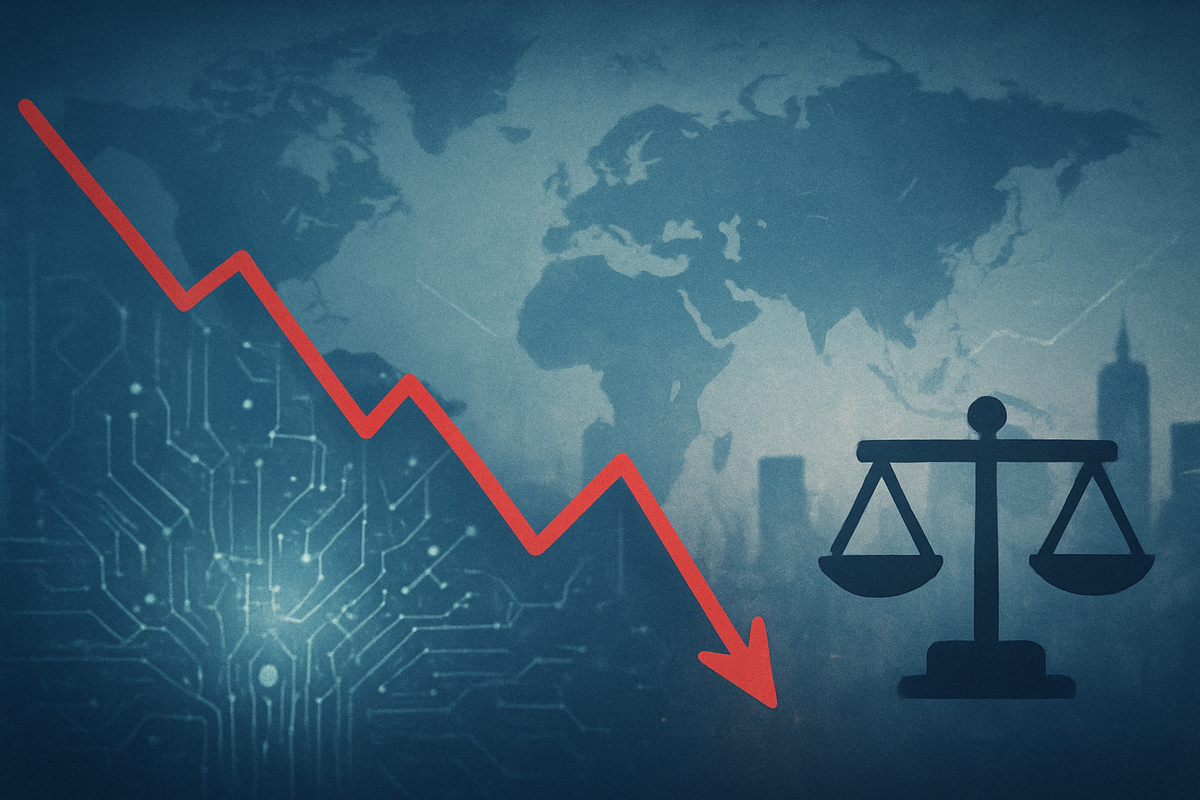
New York, NY – November 14, 2025 – Global financial markets have recently experienced a significant upheaval, marked by a sharp stock selloff driven primarily by escalating concerns over the lofty valuations of Artificial Intelligence (AI) companies and growing skepticism regarding the likelihood of imminent US interest rate cuts. This dual-pronged anxiety triggered a "risk-off" sentiment among investors, leading to considerable declines across major indices worldwide. While Wall Street has demonstrated a degree of resilience, the immediate aftermath has been characterized by heightened volatility rather than a full-fledged recovery, leaving market participants grappling with uncertainty.
The selloff, which intensified around mid-November 2025, underscored a critical re-evaluation of market fundamentals. Investors, wary of what some are calling an "AI bubble," began to pull back from high-flying technology stocks. Simultaneously, the Federal Reserve's increasingly hawkish stance, coupled with an "economic data drought" caused by a federal government shutdown, cast a long shadow over expectations for a December rate cut. This confluence of factors led to one of the most volatile periods for global equities since April, with significant implications for market stability and future investment strategies.
The Mid-November Market Tremors: A Detailed Account
The global stock selloff gained momentum on November 13th and 14th, 2025, sending ripples across continents. On November 13th, the US stock market suffered one of its worst days in months, with the S&P 500 (NYSEARCA: SPY) sinking 1.7%, the Dow Jones Industrial Average (NYSEARCA: DIA) dropping nearly 800 points (1.7%), and the tech-heavy Nasdaq Composite (NASDAQ: QQQ) losing 2.3%. This trend continued into November 14th, with early trading seeing the S&P 500 fall by 0.5%, the Dow Jones Industrial Average down 1%, and the Nasdaq Composite sliding 0.5%, although some losses were pared later in the day.
International markets mirrored this downturn. On November 14th, European exchanges saw Britain's FTSE 100 (INDEXFTSE: UKX) fall over 1.1%, Germany's DAX (INDEXDB: DAX) shed 0.7%, and France's CAC 40 (INDEXEURO: PX1) slip 0.4%. Asian markets also experienced significant declines, with South Korea's Kospi (KRX: KOSPI) sinking 3.8% and Japan's Nikkei 225 (NIKKEI: NKX) falling nearly 1.8% on the same day. The volatility was palpable, indicating a clear shift in investor sentiment away from risk.
The primary catalysts for this downturn were two-fold. Firstly, growing apprehension over the soaring valuations of AI companies led to fears of an "AI bubble." Prominent AI-related stocks, including Nvidia (NASDAQ: NVDA), Palantir Technologies (NYSE: PLTR), Tesla (NASDAQ: TSLA), Amazon (NASDAQ: AMZN), Apple (NASDAQ: AAPL), Microsoft (NASDAQ: MSFT), Alphabet (NASDAQ: GOOGL), and Meta (NASDAQ: META), experienced considerable declines. Noted short-seller Michael Burry, known for predicting the 2008 financial crisis, reportedly placed bearish bets against major AI companies, further fueling the selloff.
Secondly, investor expectations for a Federal Reserve interest rate cut in December plummeted. Just a month prior, bond futures traders had priced in a nearly certain 95% chance of a December rate cut; by November 14th, these odds had fallen to approximately 47%. This shift was driven by hawkish comments from Fed officials emphasizing persistent inflation, a resilient economy, and an "economic data drought" caused by a record 43-day federal government shutdown, which left the Fed "flying blind" on crucial economic indicators. The lack of clear data made the Fed more hesitant to commit to further easing, contributing to market unease.
Corporate Fortunes: Winners and Losers in a Volatile Landscape
The recent market turbulence has created a clear divide between companies most vulnerable to the prevailing anxieties and those better positioned to weather the storm or even thrive in a subsequent recovery.
On the losing side are predominantly companies with high valuations tied to aggressive AI growth projections and those highly sensitive to elevated interest rates. AI "superstar" technology and semiconductor companies such as Nvidia (NASDAQ: NVDA), Palantir Technologies (NYSE: PLTR), Super Micro Computer (NASDAQ: SMCI), Broadcom (NASDAQ: AVGO), Oracle (NYSE: ORCL), and Meta Platforms (NASDAQ: META) have seen sharp declines. Their business models, reliant on sustained and rapid AI expansion, become vulnerable when the profitability or sustainability of AI investments is questioned. Doubts about interest rate cuts mean higher borrowing costs, increasing the discount rate applied to their future earnings and making their current high valuations less attractive. This "multiple compression" has prompted investors to pay less for each dollar of future earnings. Similarly, AI-dependent Software-as-a-Service (SaaS) companies like Snowflake (NYSE: SNOW) are also vulnerable, as their valuations often hinge on future growth expectations that can be quickly reassessed during periods of uncertainty. Highly leveraged companies and interest-rate-sensitive sectors, including many Real Estate Investment Trusts (REITs) like Boston Properties (NYSE: BXP), also suffer from higher-for-longer rates, which directly impact their profitability by increasing debt service expenses and potentially reducing property values.
Conversely, a subsequent recovery would likely see a rotation into more stable, fundamentally strong companies. Defensive sectors such as consumer staples (e.g., Procter & Gamble (NYSE: PG), Johnson & Johnson (NYSE: JNJ)), utilities (e.g., Hydro One (TSX: H)), and healthcare are generally insulated from AI bubble concerns and offer stable demand. In a "higher for longer" interest rate environment, their steady income streams and dividend yields become more attractive. Energy stocks like ExxonMobil (NYSE: XOM) and Chevron (NYSE: CVX), and infrastructure giants like Enbridge (TSX: ENB), are also considered less sensitive to interest rates. Furthermore, value stocks and companies with strong fundamentals that may have been overlooked during the growth stock rally are poised to benefit. These include firms with robust balance sheets, consistent earnings, and reasonable valuations, such as AT&T (NYSE: T), Disney (NYSE: DIS), KeyCorp (NYSE: KEY), and Progressive (NYSE: PGR), which Bank of America identified as opportunities to diversify away from the AI trade. Even some large-cap tech companies with diversified strengths, like Microsoft (NASDAQ: MSFT), despite being caught in the broader tech selloff, are considered long-term buys due to their robust cloud platform (Azure) and pervasive AI integration across their product suite.
Wider Significance: Echoes of the Past, Shaping the Future
The mid-November 2025 selloff is more than just a temporary blip; it represents a critical juncture in broader market trends, signaling a shift from speculative exuberance to a demand for tangible profitability. This "risk-off" move is characteristic of a market recalibration, moving away from an era of seemingly limitless growth and inexpensive capital towards one that prioritizes financial discipline.
The parallels to the dot-com bubble burst of the late 1990s and early 2000s are striking. Both periods were characterized by a transformative technology (the internet then, AI now) driving immense investor enthusiasm and a substantial outperformance of US large-cap growth stocks. Speculative investment in unproven companies, followed by a sober re-evaluation of valuations, is a shared pattern. However, a key difference lies in the financial health of today's leading tech companies, which generally boast strong balance sheets and tangible earnings, unlike many unprofitable dot-com era firms. Yet, market concentration is even higher today, with a few mega-cap tech stocks holding disproportionate weight in major indices, raising concerns about systemic risk. The impact of rising interest rates as a catalyst for the dot-com bubble's demise also resonates strongly with the current doubts about rate cuts.
The ripple effects of this selloff extend beyond the tech sector. Cryptocurrencies, often seen as riskier assets, also experienced a dip, with Bitcoin falling below $100,000. Financials and utilities, while generally considered defensive, can also be sensitive to interest rate shifts. Globally, markets in Asia and Europe tracked Wall Street's performance, with chip-making firms in South Korea and Japan, major suppliers to AI giants, particularly affected.
From a regulatory and policy perspective, a significant market correction often precipitates increased scrutiny. Regulatory bodies are intensifying their focus on major tech companies due to their dominant control over essential AI inputs. Antitrust efforts are gaining momentum in both the US and the EU, aiming to curb anti-competitive practices. Organizations like the Bank of England and the International Monetary Fund (IMF) have already highlighted systemic risks within the AI investment landscape, suggesting that increased oversight or policy interventions might emerge if market stability is threatened. There is also a growing debate about the need for robust AI regulation to ensure safety and governance, which could temper unsustainable market valuations. Historically, market corrections like the dot-com bubble led to significant regulatory reforms, and similar structural changes could be anticipated in response to the current correction, particularly concerning valuation practices and investment transparency in speculative sectors.
What Comes Next: Navigating the Path Forward
The immediate future for the stock market is expected to be characterized by continued volatility, or "chop," as new economic data is digested. Despite the recent recovery from the initial sharp declines, some analysts warn of potential further pullbacks given stretched valuations and lingering uncertainties. However, several factors could support reasonable gains on a 6-12 month horizon, including strong corporate earnings, particularly in the US and technology sector, and the ongoing "all-powerful AI narrative" driving innovation and productivity gains. While aggressive Federal Reserve rate cuts are less likely, central banks are still expected to ease monetary policy further, which could provide a tailwind for valuations.
In the long term, a "U-shaped" recovery, where the market stabilizes, trades sideways, and then gradually recovers as economic clarity improves and corporate earnings rebound, appears to be a likely scenario. While some bullish projections foresee the S&P 500 reaching 9,000 in 2026 driven by AI and potential Fed overstimulation, a more cautious outlook suggests smaller gains and sharper swings. A protracted downturn or even a deeper recession remains a possibility if geopolitical events worsen, high tariffs are implemented, or a "stagflation trap" with low growth and high prices materializes.
For companies, strategic pivots are crucial. This includes diversifying revenue streams, building robust cash reserves, strengthening supply chain resilience, and prioritizing cost efficiency and cash flow generation. Strategic mergers and acquisitions could also present opportunities. Continued investment in innovation, particularly digital transformation and AI, remains critical for long-term competitiveness.
Investors are advised to maintain a disciplined and long-term approach. This means upholding a diversified portfolio across sectors, market caps, and geographies, and considering rebalancing towards more defensive sectors like healthcare and utilities. Maintaining cash reserves can provide opportunities to "buy the dip" in quality names. A focus on strong business fundamentals rather than short-term price movements is paramount, and understanding factor performance, such as the outperformance of low-volatility stocks in volatile markets, can be beneficial. Emerging markets present both opportunities, fueled by AI investments and receding trade tensions, and challenges, including vulnerability to geopolitical shocks and potential currency volatility.
Comprehensive Wrap-up: A Market in Transition
The global stock selloff in mid-November 2025, sparked by AI valuation concerns and doubts about US interest rate cuts, served as a stark reminder of the market's inherent vulnerabilities and its sensitivity to both technological speculation and monetary policy. The immediate aftermath has seen Wall Street demonstrate a degree of resilience, but the underlying currents suggest a market in transition, moving towards a more discerning assessment of value and risk.
Key takeaways from this period include the continued influence of AI as a transformative force, albeit one now subject to greater scrutiny regarding its immediate profitability and sustainable valuations. The Federal Reserve's cautious stance on interest rates, driven by persistent inflation and economic data gaps, underscores a shift towards a "higher for longer" interest rate environment, impacting growth-oriented companies. The market's reaction also highlighted the significant concentration of wealth and influence within a few mega-cap tech companies, raising questions about systemic risk and the need for regulatory oversight.
Moving forward, the market is likely to remain volatile, characterized by periods of both optimism and apprehension. Its resilience will be tested by ongoing economic data, the Federal Reserve's future policy decisions, and geopolitical developments. Underlying vulnerabilities include stretched valuations in certain tech segments and the potential for a "K-shaped recovery," where some sectors thrive while others lag.
The significance of this event lies in its potential to reshape investment strategies, encouraging a greater focus on fundamentals, diversification, and risk management. Its lasting impact could be a more mature approach to valuing nascent technologies like AI, demanding clear pathways to profitability rather than relying solely on speculative growth narratives. Investors should closely monitor corporate earnings reports, inflation data, Federal Reserve communications, and any regulatory developments concerning big tech and AI in the coming months. The ability of companies to adapt to a higher-for-longer interest rate environment and demonstrate tangible returns from their AI investments will be crucial determinants of future market performance.
This content is intended for informational purposes only and is not financial advice




